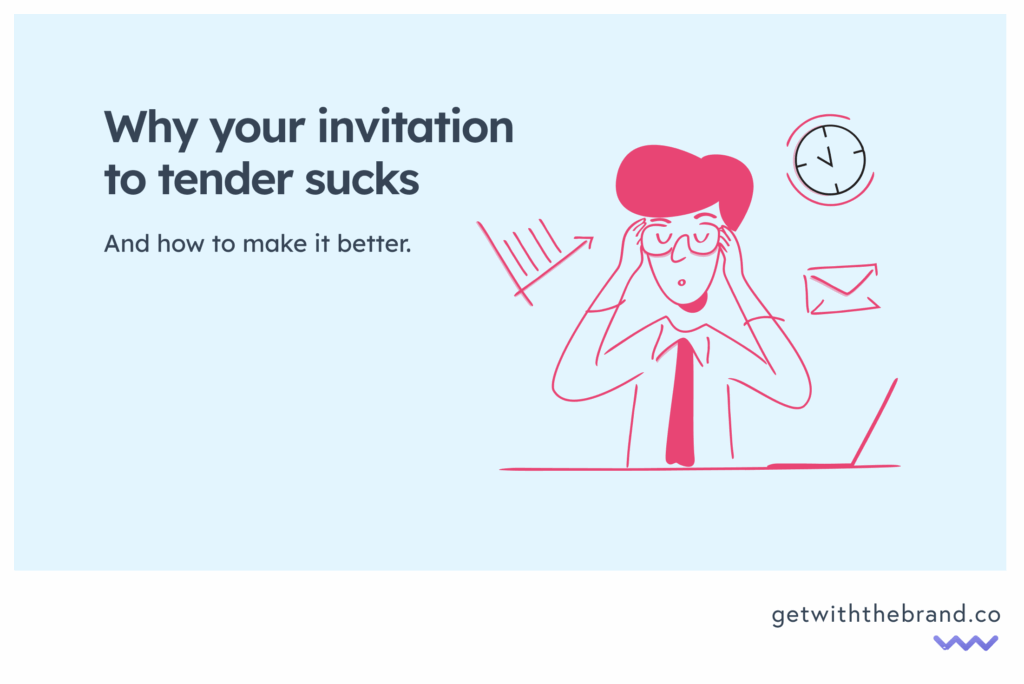As a UX Consultant, I research, design and deliver accessible websites and digital products that support user needs and the goals of organisations. I’m sticking my neck out to say that the tender system does not work in my industry.
My mission is to make the internet less frustrating—for businesses, government entities, and everyday users. A key part of that mission is fixing how projects are scoped and budgeted.
What most organisations do when it’s time to redesign their website or product is create an invitation to tender. If you’re reading this, you probably know what that is, but for clarity:
An invitation to tender (or request for quote) is a formal, structured procedure for generating competing offers from different potential suppliers or contractors looking to obtain an award of business activity in works, supply, or service contracts.
Someone in the digital department, procurement or marketing, will be given the task of getting quotes for a website redesign or new digital product. The process usually evolves from a review of the thing being replaced. What works, what doesn’t, what we like and don’t like, what additional features can we have, what would make it better/cooler etc.
It’s not unusual for this process to include a look at other websites, cherry-picking features or nice-to-haves. A board might then look at the resulting Scope of Works, agree or disagree and add some ideas of their own. Each department might be asked to weigh in. Or not. A lot of back and forth can happen while everyone has their say.
Someone is then tasked with presenting all that in a document that a supplier can then use to provide a quote.
Often it’s a wish list. Here’s what we want, tell us how much it costs.
The tender trap: why the tender system doesn’t work for digital projects.
The tendering process is designed to compare competing suppliers based on a predefined scope. But in UX design, that scope is rarely clear from the start. Here’s why the current system fails:
It assumes the problem is already well-defined.
Without adequate research and discovery, it’s impossible to know what the project requirements are. So project scope is based on technical features and broad assumptions about what the user needs (if the latter is a consideration at all).
The scope of works is drafted by well-meaning employees who may not have a full understanding of the external factors that matter when redesigning a website or digital product, or may be under pressure to request features and functionality that serve organisational silos instead of business and user needs.
They may be unaware of other issues within the organisation, or they may struggle to see where priorities lie. This isn’t me dismissing employees, it’s me empathising with them. It’s really difficult to be objective when you have insider knowledge. And you’re often overruled at the 11th hour by someone higher up who is party to information that you’re not. Creating a solid invitation to tender is a tough gig.
It encourages guesswork.
When agencies and consultants are asked to provide a quote for work that hasn’t been fully researched and scoped, one of two things happens: The supplier has to make educated guesses to fill in the blanks (inflating the estimate) or roll with it and ask the client to cover unexpected costs later in the project. Neither are ideal.
The tender often raises more questions than is answers. Again, the provider is left guessing or questioning. For example, the client needs a simple CMS, they suggest WordPress + ACF in the tender. The supplier has been getting great feedback for Gutenberg, clients like to use is because it’s more flexible and visually aligned. They don’t know enough about the project to make this recommendation, so they quote for ACF. That’s locked in.
It prioritises cost over value.
The cheapest bid often wins, but this doesn’t necessarily result in the best outcome. Good UX work focuses on long-term impact rather than short-term savings. A UX Consultant is uniquely positioned to help you spend your budget on the right things, generating the strongest ROI possible.
It forces professionals to work for free.
Most tenders require extensive proposals or speculative work without compensation. This means agencies and consultants have to recoup the costs elsewhere – usually resulting in higher fees for everyone. We don’t expect a builder to give us a quote for free based on a wish-list (and a thousand variables – which taps, which building materials, do you want double glazing, do you care about passive energy etc) yet we assume digital professionals can.
It discourages collaboration and forces rigidity.
The best UX projects involve close collaboration between the client and the designer. A rigid tendering process limits this and makes it harder to refine ideas as new insights emerge. The entire UX process is built on the need to pivot, as each insight is used to inform the next. Locking in a rigid approach at the start inevitably leads to two things: scope creep and the wrong solution. A UX Consultant doesn’t rely on a fixed process, instead they lean on a set of methodologies, selecting the correct ones to solve each problem as it arises. This flexibility is essential for a successful project outcome.
Read: 18 tools a UX consultant (and you!) can use..
It leads to misaligned expectations and disappointing outcomes.
When a project is defined up-front without proper research, it may not meet user needs or business objectives. A poorly scoped brief can miss critical requirements and big-picture thinking. This leads to costly scope-creep, iteration hell and in some cases can derail the project entirely.
Read: Why website projects go off the rails
Why I don’t work for free (and why that’s good for you).
Today, not for the first time, at the end of a 30-minute initial chat with a potential client, I was asked to visit their office to meet the CEO and explain my process. I politely declined, knowing it might cost me the gig.
To be clear, I’m not against in-person meetings. I’m against the expectation that I give away hours of unpaid time while someone essentially enlists my help to define their brief for free.
Here’s why I suggest a paid discovery process instead:
Blind contracts are risky for vendors and suppliers.
Committing $50k to a project without proper research is a gamble. A brief paid discovery phase lets us test working together first. If it’s not a great fit, you still leave with tangible work you can use elsewhere. The alternative locks clients in to a ‘solution’ which may not be the right one.
Unpaid meetings result in a cost, which has to get passed on somewhere.
An hour across town is really three hours gone — half a day’s earnings. For a company of one, that’s significant. To cover those losses, I’d need to raise rates. That means clients who have chosen a supplier or two based on their own research are subsidising those who cast a wide net to everyone – suitable or not.
A better alternative to tenders: why start with a paid discovery phase?
Instead of asking for free work, invest in a small upfront fee for a discovery phase.
During discovery, I work with stakeholders to:
- Understand user needs and business goals
- Define requirements
- Develop a realistic scope
- Create wireframes or prototypes (if the budget allows)
At the end, you have a clear, well-defined brief that allows for like-for-like quotes — without inflated costs or mid-project surprises.
Paid discovery also kicks off what Blair Enns calls the value conversation: shifting the question from “How much will it cost?” to “What is the value of solving this?” That’s where better projects start. That’s where an outsider can help you work out where to spend your budget and how to get the best bang for your buck.
What if you’re stuck with a tender process?
I know some organisations are required by policy to put work out to tender. That doesn’t have to mean repeating the same broken cycle. One simple step is to run a small, paid discovery project before you write the tender. It gives you a clear brief, realistic scope, and like-for-like proposals that make sense. Everyone still gets to compete fairly — but you’ve removed the guesswork and dramatically improved your odds of a successful project.
When it comes to digital projects, the tender process is broken. It’s unfair, inefficient, and costly for everyone involved.
Paid discovery is a simple option that creates clarity, confidence, and a fair starting point for both sides. The alternative is gambling with time, money, and goodwill.
If you’re serious about your digital project, invest in understanding what you need before asking for a price tag. Let’s build something great — without the frustration.


